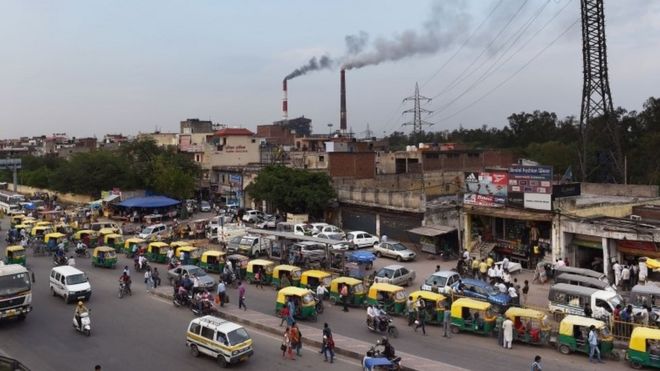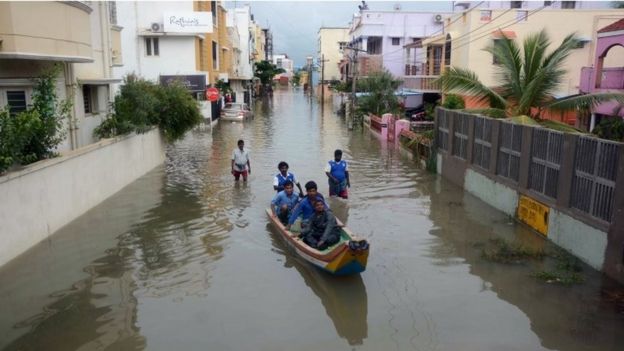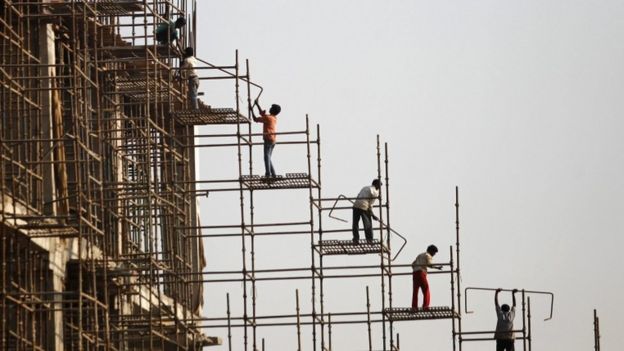- 1 December 2015
 Image copyrightAFP
Image copyrightAFPIn the lead up to this week’s critical UN conference aimed at agreeing on a new global approach to climate change, India has indicated its intent to build infrastructure and vastly increase industrial manufacturing as a means of giving hundreds of millions of citizens a better quality of life.
It has said it will do all this while decarbonising, or reducing the amount of carbon used per unit of growth, by 35% of its 2005 levels.
In the same breath, it says: “More than half of the India of 2030 is yet to be built.”
But the kind of country that India wants to make – mines, airports, seaports, big cities, industrial corridors, chemical and pharmaceutical industries, water-guzzling coal and nuclear power plants – is not the kind of India required to sustain communities and confront climate shocks.
India, other nations and even many NGOs, are not talking about the elephant in the room – growth.
Real possibility
India’s growth addiction is as deadly for planetary health as our addiction to carbon. But talking about decarbonising our economies hides this fact.
Modern economic growth is a child of the industrial revolution. Three centuries of unrestrained economic growth have brought us to a point where it is certain that we will soon see a 2C warmer world with all its associated dangers.
Barring drastic changes over the next week, a 4C warmer world is a real possibility.
Just the rises in sea level associated with a 4C warmer world will threaten 55 million people living along the Indian coast, including three million in Chennai, 12 million in Kolkata (formerly Calcutta) and 11 million in Mumbai, according to US-based scientific organisation Climate Central.
Unfortunately, carbon is not the only boundary that is being stretched in the heady ride up the growth curve.
Water issues
Burdened by over-extraction and pollution, India’s groundwater aquifers are on the brink of collapse.
Nearly 80% of surface water is polluted, according to WaterAid.
Drought afflicts 18 of 29 states of the country, even as many parts of the southern states of Tamil Nadu and Andhra Pradesh reel under floods.
 Image copyrightAFP
Image copyrightAFPLast month’s rains in Chennai may or may not have been induced by climate change. But the floods were certainly a result of inappropriate land-use – where roads, railways and buildings were constructed with no regard for local movement and distribution of the earth’s water.
Land-use associated with India’s threat to grow will erode the ability of communities to face an uncertain future.
In Tamil Nadu alone, just seven coastal districts have 35,750MW of coal-powered thermal power plants in various stages of licensing or construction.
The larger ones, like the 4,000MW plant in Cheyyur, have associated captive facilities – jetties, coal yards, coal and seawater conveyor corridors, ash pipelines and ash ponds.
Intact ecosystems should be left alone and degraded ones repaired to help us face our future. But exactly the reverse is happening – and even the big corporations do not appear to be sincere.
Different light
Consumer goods giant Unilever, for example, prides itself as the gold standard in socially responsible behaviour. Chief executive Paul Polman has said governments must set clear CO2 targets to force low-carbon innovation.
But in the pretty south Indian hill town of Kodaikanal, many residents see the company in a different light.
Here, a Unilever subsidiary – Hindustan Unilever – has been accused of operating a mercury thermometer factory which has hurt workers and contaminated the site and its surroundings with mercury – a toxic metal that can hurt the brain and kidneys and cause birth defects.
Unilever subsequently shut down its factory and ordered an investigation into the functioning of the unit.
Fifteen years after the contamination was discovered, the site remains polluted and is leaking mercury into the bio-diverse watershed forest at its fence-line.
Studies as recently as in June and October confirm that the factory is leaking toxic mercury into the catchment of the Pambar river which empties into the river Vaigai which supplies water and fish to three water-scarce districts of Tamil Nadu.
Unilever has said that studies had showed “no adverse impact on the environment in Kodaikanal, except in some areas of the factory premises”.
“We are keen to continue work on clearing up the factory site,” a statement issued by the company said.
 Image copyrightReuters
Image copyrightReutersHere, Unilever has the choice of walking its talk. Technology exists to reduce mercury to levels that are found in unpolluted soils. Doing this will protect the water security of downstream communities.
But Unilever is citing “techno-commercial considerations” to justify a clean-up standard that will leave behind 200 times more mercury than in unpolluted soils.
It is this emphasis on what is commercially viable over what is naturally desirable that gives the lie to phrases like sustainable development.
Green growth proponents extend the tempting promise of continued over-consumption by merely changing how things are produced.
But unless we question who produces, what is produced, for whom and why, even a successful outcome in Paris will not keep us out of harm’s way.
Nityanand Jayaraman is a Chennai-based writer and social activist
http://www.bbc.com/news/world-asia-india-34960929?post_id=10153413520724686_10153789755594686
Leave a Reply